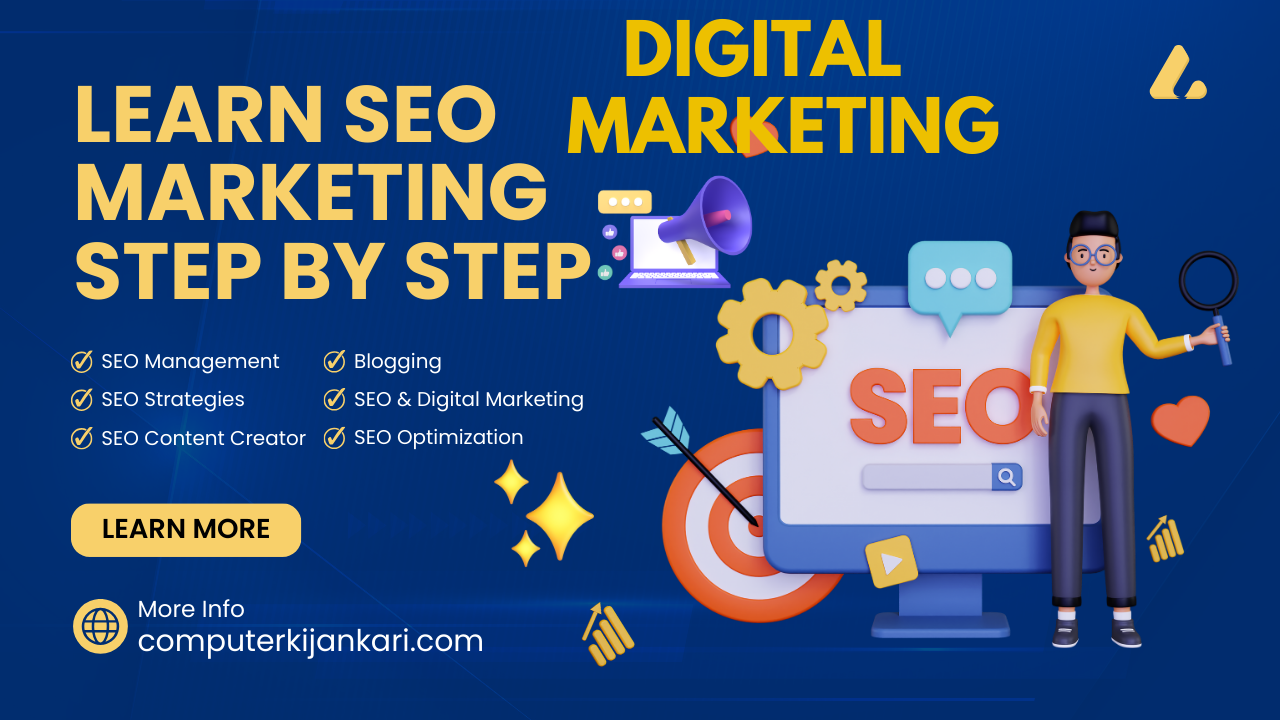Table of Contents
Definition of SEO in digital marketing
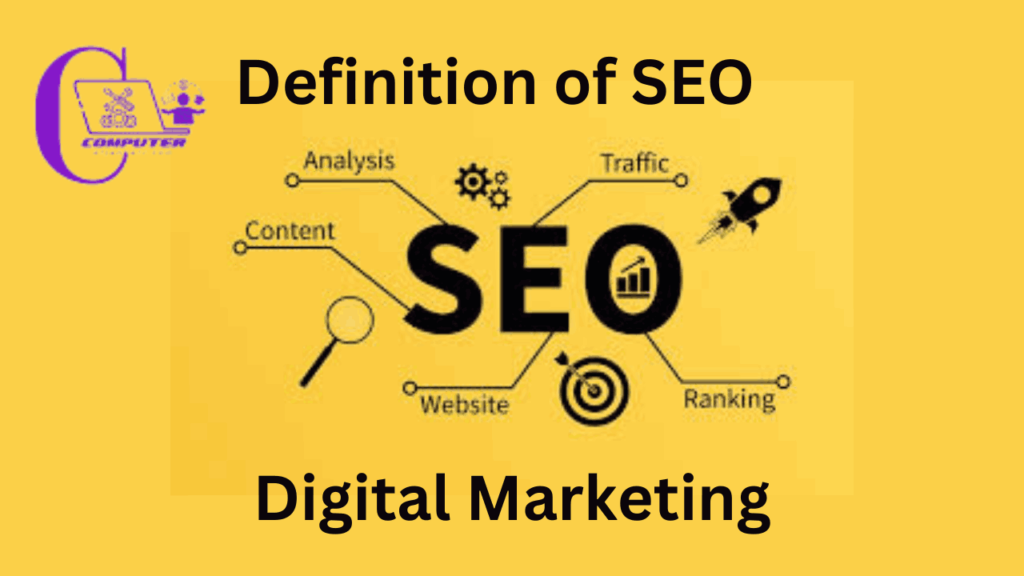
SEO in Digital Marketing: website’s visibility and ranking on search engine results pages (SERPs). The primary objective of SEO is to optimize various elements of a website, both on-page and off-page. SEO, or search engine optimization, is a set of practices aimed at enhancing a page in order to improve its relevance and credibility in the eyes of search engines.
This involves strategic use of keywords, the creation of high-quality and relevant content, improving website structure and navigation, obtaining backlinks from reputable sources, and ensuring a positive user experience. The ultimate goal of SEO is to increase organic (non-paid) traffic to a website, leading to an improved online presence, higher visibility, and better chances of attracting and engaging the target audience. SEO is an essential component of digital marketing strategies, helping businesses and individuals enhance their online presence and compete effectively in the digital landscape.
Understanding Search Engines

Understanding search engines involves grasping the fundamental concepts and mechanisms behind how these online platforms operate to retrieve and present information. Search engines are complex software systems designed to index, crawl, and rank web pages based on relevance to user queries. The following key elements are usually included in the process:
1. Indexing
Search engines use automated bots, commonly known as crawlers or spiders, to browse and index web pages. This indexing process involves analyzing the content, structure, and meta-information of each page and storing this information in a vast database.
2. Crawling
Crawling is the systematic process of navigating through the interconnected web of pages. Search engine crawlers follow links from one page to another, discovering and indexing content along the way. It’s a continuous process, ensuring that the search engine’s index stays updated with the latest information
3. Ranking
When a user submits a query, the search engine retrieves relevant pages from its index and ranks them based on various factors. These factors include the relevance of content, keyword usage, backlinks from authoritative sources, user experience, and other algorithmic considerations.
4. Algorithm
Search engines employ sophisticated algorithms to determine the order in which search results appear. These algorithms are continually updated to provide users with the most accurate and valuable information. Major search engines like Google, Bing, and Yahoo closely guard the specifics of their algorithms to prevent manipulation.
5. User Intent
Understanding user intent is crucial for search engines. They aim to deliver results that align with what users are seeking when they enter a search query. As a result, search engines strive to interpret the context, semantics, and purpose behind user searches.
6. SERPs (Search Engine Results Pages)
The pages displayed after a user initiates a search constitute the SERPs. These pages feature a mix of organic results (unpaid) and paid advertisements. The ranking of organic results is determined by the search engine’s algorithm, emphasizing relevance and quality.
In summary, understanding search engines involves recognizing the intricate processes of crawling, indexing, and ranking that enable these platforms to deliver accurate and valuable results to users based on their search queries. The field of search engine optimization (SEO) revolves around optimizing websites to align with these processes, ultimately improving their visibility and relevance in search engine results.
On-Page Optimization
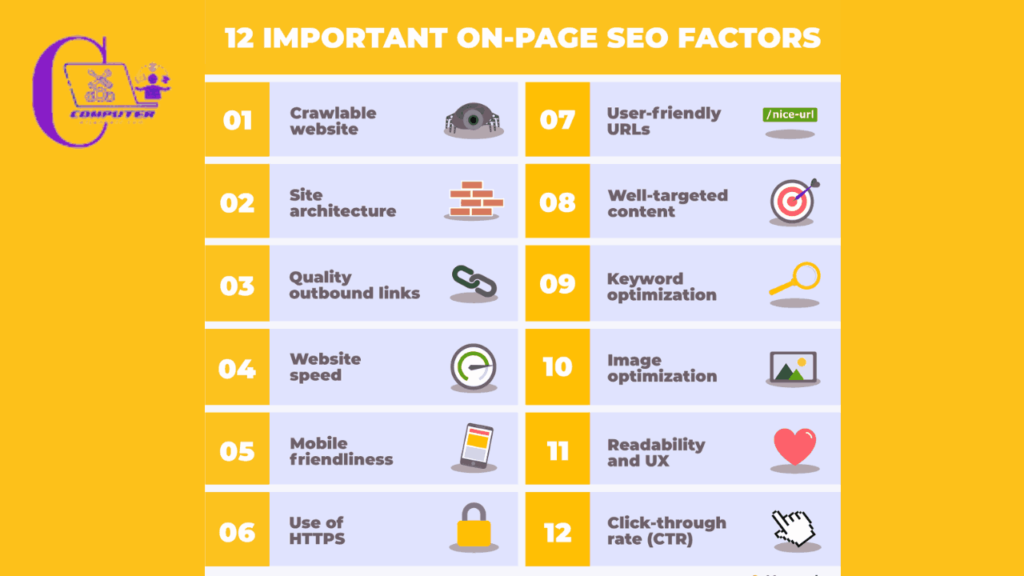
On-page optimization refers to the set of techniques and practices used to enhance and optimize various elements directly within a website to improve its search engine visibility and overall performance. These optimizations are implemented on the web pages themselves, influencing how search engines understand, interpret, and rank the content. The goal is to make the pages more relevant, user-friendly, and accessible to both search engines and visitors. Here are key aspects of On-Page optimization:
1. Content Quality and Relevance:
- Ensure that the content on each page is high-quality, informative, and relevant to the target audience.
- Incorporate relevant keywords naturally into the content, headings, and meta tags.
2. Title Tags:
- Optimize the title tags for each page with concise and descriptive titles that include important keywords.
- Keep title tags within the recommended character limits to ensure they display correctly in search results.
3. Meta Descriptions
- Craft compelling meta descriptions that summarize the content of the page and encourage users to click through from search results.
- Include relevant keywords, but focus on providing valuable information to users.
4. URL Structure:
- Make clear, readable, and brief URLs with pertinent keywords.
- Avoid using complex or cryptic URLs, and use hyphens to separate words.
5. Header Tags:
- Use header tags (H1, H2, H3, etc.) to structure content and emphasize key points.
- Include relevant keywords in the header tags to signal the importance of specific sections.
6. Keyword Placement:
- Strategically place keywords throughout the content, giving priority to the beginning of the page, headings, and subheadings.
- Keep free of keyword stuffing and focus on writing content that is appealing and organic.
7. Image Optimization:
- Make use of alt attributes and meaningful filenames to optimize your photographs.
- Compress images to reduce file sizes for faster page loading.
8. Internal Linking:
- Include relevant internal links to connect pages within your website.
- Use descriptive anchor text that provides context about the linked content.
9. Mobile-Friendly Design
- Ensure that the website is optimized for mobile devices, providing a seamless and responsive user experience.
10. Page Loading Speed:
- Reduce the number of unnecessary stories, use computer caching, and compress photos to improve website loading speed.
- Faster loading times contribute to a positive user experience and can positively impact search rankings.
On-page optimization is a crucial aspect of SEO, as it directly influences how search engines perceive and rank individual web pages. By implementing these practices, website owners can enhance their pages’ relevance, user experience, and overall performance in search engine results.
Off-Page Optimization

Off-page optimization refers to the set of activities and strategies implemented outside of a website to enhance its online visibility and improve its authority, relevance, and trustworthiness in the eyes of search engines. Unlike on-page optimization, which focuses on optimizing elements within the website itself, off-page optimization involves actions taken externally to attract attention and build credibility. Key aspects of off-page optimization include:
1. Link Building:
- Obtain backlinks of the finest caliber from reputable and relevant websites.
- Focus on natural link-building strategies to improve the website’s link profile.
2. Social Media Engagement:
- Build a strong presence on social media platforms by sharing and promoting content.
- Encourage social sharing to increase the reach and visibility of the website’s content.
3. Brand Mentions:
- Monitor and build brand mentions across the web, even without a direct link. Mentions contribute to brand awareness and credibility.
4. Social Bookmarking:
- Submit and share content on social bookmarking sites to increase visibility and drive traffic.
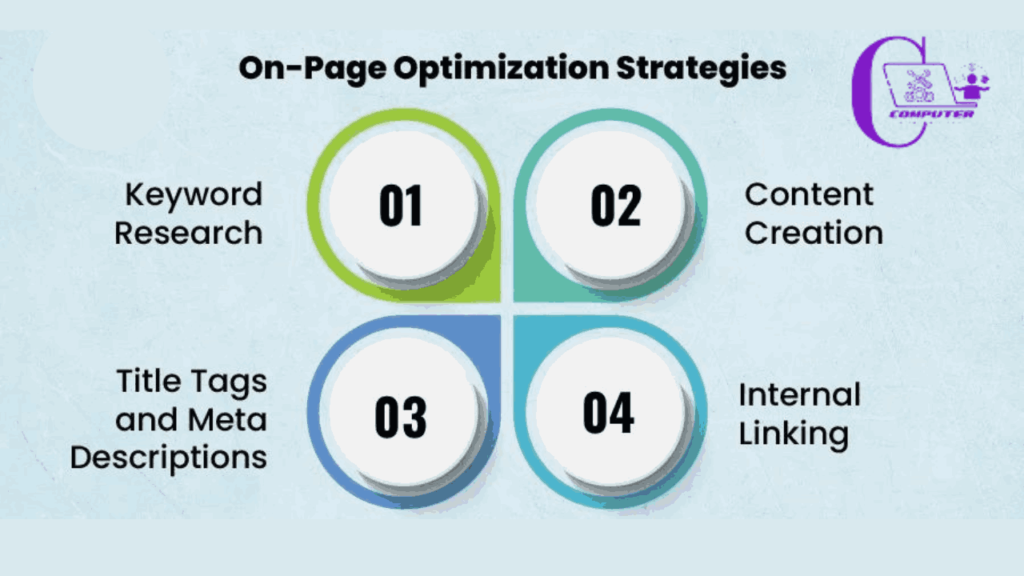
5. Influencer Outreach:
- Collaborate with influencers and industry experts to promote content and gain credibility in the industry.
6. Content Marketing:
- Create high-quality, shareable content that naturally attracts links and social shares.
- Distribute content through various channels, such as guest posting, article submissions, and content syndication.
7. Online Reviews and Ratings:
- Encourage positive reviews on relevant platforms to build trust and credibility.
- Respond to reviews, both positive and negative, to engage with the audience.
8. Local SEO:
- Optimize the website for local search by creating and verifying a Google My Business listing.
- Encourage local reviews and citations to improve local search rankings.
9. Forum Participation:
- Engage in industry-related forums and communities to establish authority and contribute valuable insights.
- Include a link to the website in the forum signature, if allowed.
10. Guest Blogging:
- Contribute guest posts to reputable websites in the industry to gain exposure and build backlinks.
- Ensure that guest content is relevant, high-quality, and adds value to the target audience.
Off-page optimization plays a crucial role in demonstrating the website’s credibility and authority to search engines. The quality and quantity of backlinks, social signals, and overall online presence contribute to the website’s ability to rank well in search engine results. A well-executed off-page optimization strategy complements on-page optimization efforts, creating a holistic approach to improving a website’s overall search engine performance.
Technical SEO
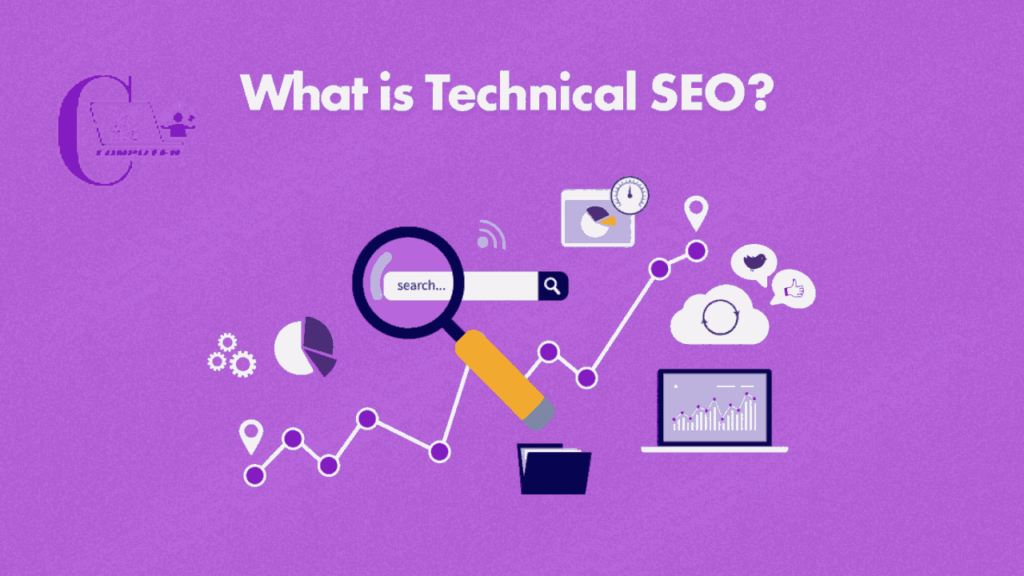
Technical SEO refers to the optimization of a website’s technical elements and infrastructure to improve its search engine visibility and performance. Unlike on-page and off-page optimization, which focus on content and external factors, technical SEO deals with aspects that are related to the website’s architecture, coding, and overall technical setup. The primary goal is to ensure that search engines can efficiently crawl, index, and understand the content on the website These are the major elements of technical SEO:
1. Website Speed and Performance:
- Optimize page loading times to enhance the user experience and satisfy search engine ranking algorithms.
- Compress images, minimize CSS and JavaScript files, and leverage browser caching.
2. Mobile-Friendly Design:
- Ensure that the website is responsive and provides a positive user experience on mobile devices.
- Google, in particular, considers mobile friendliness as a ranking factor.
3. Crawlability and Indexing:
- Allow search engine bots to crawl and index all relevant pages.
- Use a robots.txt file to control which areas of the site should not be crawled and ensure that important pages are not blocked.
4. XML Sitemap:
- Create and submit an XML sitemap to search engines to help them understand the structure and hierarchy of the website’s content.
- Regularly update the sitemap to reflect changes on the site.
5. Canonicalization:
- When duplicate content is present, use canonical tags to identify the preferred version of a URL.
- It prevents issues related to duplicate content and ensures that search engines understand the primary version of a page.
6. SSL/HTTPS Security:
- Secure the website with an SSL certificate to enable HTTPS.
- Google considers secure websites as a positive ranking factor.
7. Structured Data Markup (Schema):
- Implement structured data markup to provide search engines with additional context about the content on the page.
- Enhances the display of rich snippets in search results.
8. Website Architecture:
- Create a logical and user-friendly site structure with clear navigation.
- Ensure that important pages are easily accessible and that the URL structure is clean and descriptive.
9. 404 Error Handling:
- Implement a custom 404 error page to improve the user experience when a page is not found.
- Regularly monitor and fix broken links.
10. Server and Hosting Configuration:
- Choose a reliable hosting provider to ensure optimal server performance.
- Optimize server settings for speed and responsiveness.
Technical SEO is essential for laying the foundation for a website’s overall search engine optimization strategy. By addressing technical issues and ensuring a well-optimized technical infrastructure, websites can enhance their chances of ranking higher in search engine results and providing a better experience for users and search engine bots alike.
Measuring SEO Success
Measuring SEO success involves evaluating the effectiveness of search engine optimization efforts in achieving predefined goals and objectives. It is crucial to monitor and analyze various metrics to understand the impact of SEO strategies on a website’s visibility, traffic, and overall performance. Here are key aspects to consider when measuring SEO success:
1. Keyword Rankings:
- Monitor the ranking positions of target keywords in search engine results.
- Improvements in keyword rankings often indicate increased visibility.
2. Organic Traffic:
- Analyze the amount of organic (non-paid) traffic generated by the website.
- Increasing organic traffic suggests that the website is being discovered by a larger audience through search engines.
3. Conversion Rates:
- Track the conversion rates of organic traffic, such as form submissions, purchases, or other desired actions.
- A rise in conversion rates indicates that the SEO efforts are attracting relevant and engaged visitors.
4. Click-Through Rate (CTR):
- Evaluate the CTR of organic search results in comparison to impressions.
- A higher CTR suggests that the content is compelling and relevant to users.
5. Bounce Rate:
- Monitor the bounce rate to understand how many visitors leave the site after viewing only one page.
- A lower bounce rate generally indicates that users find the content valuable and engaging.
6. Backlink Metrics:
- Assess the quantity and quality of backlinks to the website.
- High-quality backlinks from authoritative sources contribute to improved SEO performance.
7. Page Load Speed:
- Measure the page load speed, as faster-loading pages tend to have better user experiences and can positively impact rankings.
- Utilize resources such as Google PageSpeed Insights to evaluate and enhance load times.
8. Indexed Pages:
- Ensure that search engines have indexed all relevant pages on the website.
- Regularly check the number of indexed pages to identify potential issues.
9. Social Signals:
- Evaluate the impact of SEO on social media, such as increased shares, likes, and comments.
- Social signals can indirectly contribute to improved search engine rankings.
10. Return on Investment (ROI):
- Assess the financial impact of SEO efforts by comparing the investment in optimization with the revenue generated.
- ROI analysis helps justify the resources allocated to SEO activities.
11. Google Analytics and Search Console Data:
- Utilize data from Google Analytics and Google Search Console to gain insights into user behavior, search queries, and website performance.
- Track changes over time and identify areas for improvement.
Measuring SEO success is an ongoing process that involves continuous monitoring, analysis, and adaptation of strategies. By regularly evaluating these metrics, businesses and website owners can gain a deeper understanding of the effectiveness of their SEO efforts and make informed decisions to optimize for better results.
Common SEO Mistakes
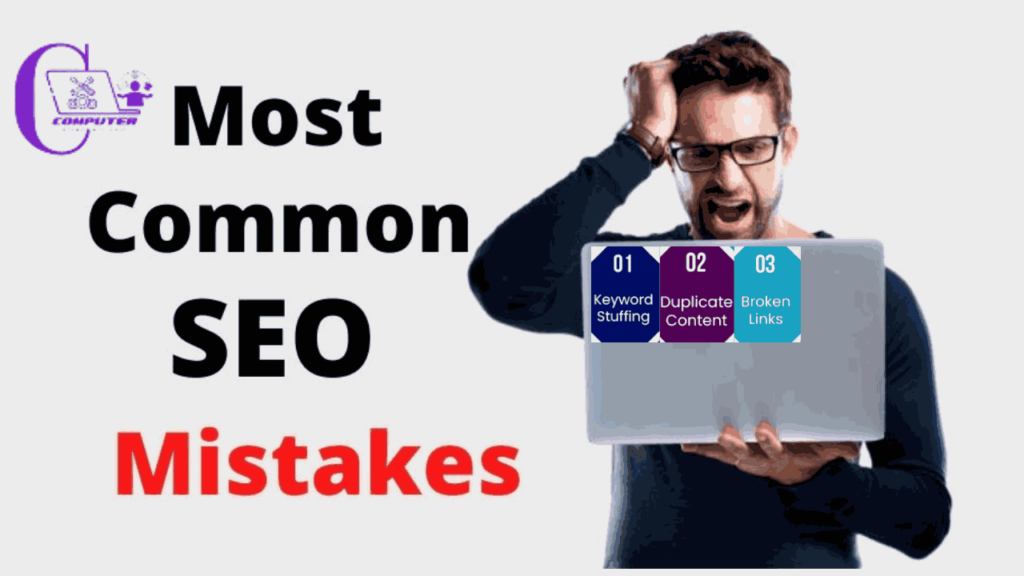
Common SEO mistakes are errors or oversights made by website owners, digital marketers, or SEO practitioners that can negatively impact the performance and visibility of a website in search engine results. Avoiding these mistakes is crucial for maintaining a strong online presence and ensuring that search engines can properly index and rank a website. Here are some common SEO mistakes
1. Ignoring Mobile Optimization:
- Neglecting to optimize a website for mobile devices can lead to poor user experiences and negatively affect search rankings, especially since mobile-friendliness is a key ranking factor.
2. Keyword Stuffing:
- Overloading content with excessive keywords in an attempt to manipulate search engine rankings can result in poor user experience and may lead to penalties from search engines.
3. Neglecting Title Tags and Meta Descriptions:
- Ignoring or using generic title tags and meta descriptions can reduce the click-through rate from search results and impact the overall SEO performance.
4. Not Creating Quality Content:
- Focusing on quantity over quality can harm a website’s reputation and rankings. Content should be valuable, relevant, and well-written to engage users and satisfy search intent.
5. Broken Links and Redirect Issues:
- Broken links and improper redirects can lead to a poor user experience and negatively impact SEO. Regularly check and fix broken links, and ensure proper redirection when necessary.
6. Duplicate Content:
- Having identical or very similar content on multiple pages can confuse search engines and result in lower rankings. To identify a page’s recommended version, use original tags.
7. Ignoring Technical SEO:
- Neglecting technical aspects such as site speed, crawlability, and proper indexing can hinder search engine bots from effectively crawling and indexing a website.
8. Not Optimizing Images:
- Failing to optimize images for size and relevance can slow down page loading times, negatively affecting user experience and search rankings.
9. Ignoring Local SEO:
- Neglecting to optimize for local search can be a significant oversight for businesses with a local presence. Ensure accurate business information, local keywords, and Google My Business optimization.
10. Ignoring Analytics Data:
- Neglecting to regularly review analytics data from tools like Google Analytics and Google Search Console can result in missed opportunities for improvement.
11. Overlooking Backlink Quality:
- Prioritizing quantity over quality when it comes to backlinks can lead to penalties from search engines. Focus on acquiring high-quality, relevant backlinks from authoritative sources.
12. Ignoring Social Signals:
- Disregarding the impact of social media on SEO can result in missed opportunities for increased visibility and social signals that can indirectly influence search rankings.
13. Failure to Keep Up with Algorithm Changes:
- SEO algorithms are continually evolving. Failing to stay updated on algorithm changes and adapt strategies accordingly can lead to a decline in search rankings.
13. Failure to Keep Up with Algorithm Changes:
- SEO algorithms are continually evolving. Failing to stay updated on algorithm changes and adapt strategies accordingly can lead to a decline in search rankings.
Avoiding these common SEO mistakes requires a proactive approach, ongoing monitoring, and a commitment to providing a positive user experience. Regularly auditing and adjusting SEO strategies based on best practices and algorithm updates is essential for long-term success.
White Hat SEO
White-hat SEO refers to ethical and legitimate search engine optimization practices that aim to improve a website’s visibility and ranking in search engine results pages (SERPs) through strategies and techniques that align with search engine guidelines. The focus of white-hat SEO is on providing value to users, creating high-quality content, and implementing tactics that comply with the rules and policies set by search engines. Here are key principles and practices associated with white-hat SEO:
White Hat SEO

White-hat SEO refers to ethical and legitimate search engine optimization practices that aim to improve a website’s visibility and ranking in search engine results pages (SERPs) through strategies and techniques that align with search engine guidelines. The focus of white-hat SEO is on providing value to users, creating high-quality content, and implementing tactics that comply with the rules and policies set by search engines. Here are key principles and practices associated with white-hat SEO:
1. Quality Content Creation:
- Emphasis is placed on creating valuable, relevant, and authoritative content that addresses the needs and interests of the target audience.
2. Keyword Optimization:
- Careful and strategic use of keywords in content, meta tags, and other on-page elements without resorting to keyword stuffing.
3. Proper HTML Markup:
- Ensuring clean and semantic HTML markup that facilitates search engine crawlers in understanding the structure and content of web pages.
4. Natural Link Building:
- Acquiring backlinks through organic and ethical means, such as creating shareable content that naturally attracts links or engaging in partnerships with reputable websites.
5. User Experience Focus:
- Prioritizing a positive user experience by optimizing website design, navigation, and page load speed to enhance usability.
6. Responsive Design:
- Developing websites that are mobile-friendly and responsive, ensuring a consistent and user-friendly experience across different devices.
7. Transparent and Ethical Practices:
- Conducting SEO activities transparently, following ethical guidelines, and avoiding deceptive or manipulative practices that violate search engine policies.
8. Respecting Copyright and Intellectual Property:
- Adhering to copyright laws and respecting intellectual property rights when creating and using content on the website.
9. Structured Data Markup (Schema):
- Implementing structured data markup (Schema) to provide additional context to search engines about the content on the page.
10. Regular Monitoring and Adaptation:
- Regularly monitoring website performance, user behavior, and search engine analytics to adapt strategies based on changes in search algorithms or user trends.
11. Compliance with Guidelines:
- Adhering to the guidelines and recommendations provided by major search engines, such as Google’s Webmaster Guidelines.
White-hat SEO is contrasted with black-hat SEO, which involves tactics that seek to manipulate search engine algorithms through deceptive and unethical means. White-hat SEO strategies are considered more sustainable and less likely to result in penalties from search engines, ultimately contributing to the long-term success and credibility of a website in the digital landscape.
The future of SCO
The future of SEO (search engine optimization) is likely to be shaped by ongoing technological advancements, changes in user behavior, and updates in search engine algorithms. While predicting the exact trajectory of SEO is challenging, several trends and developments suggest the potential direction of the future:
1. Artificial Intelligence (AI) and Machine Learning:
- The integration of AI and machine learning in search algorithms is expected to become more prominent. Search engines are likely to use AI to better understand user intent, deliver more personalized results, and identify patterns in user behavior.
2. Voice Search Optimization:
- With the increasing prevalence of voice-activated devices and virtual assistants, optimizing content for voice search is becoming crucial. SEO strategies will need to adapt to conversational and natural language queries.
3. User Experience (UX) as a Ranking Factor:
- Google’s focus on providing a positive user experience is likely to intensify. Factors such as page load speed, mobile friendliness, and overall website usability are expected to play an even more significant role in search rankings.
4. E-A-T (Expertise, Authoritativeness, Trustworthiness):
- Google emphasizes the importance of E-A-T in assessing the quality of content. Future SEO strategies will likely prioritize demonstrating expertise, building authority, and establishing trustworthiness in content creation.
5. Mobile-First Indexing:
- As more users access the internet through mobile devices, search engines are likely to continue prioritizing mobile-first indexing. Websites that offer a seamless mobile experience will have a competitive advantage in search rankings.
6. Video Content Optimization:
- Video content is becoming increasingly popular, and search engines are expected to give more weight to video content in search results. Optimizing video content, including proper metadata and captions, will be essential for SEO.
7. Featured Snippets and Zero-Click Searches:
- Featured snippets and zero-click searches, where users obtain information directly from search results without clicking through to a website, will influence SEO strategies. Optimizing content for snippet inclusion and providing concise, valuable information may become more crucial.
8. Local SEO and Micro-Moments:
- Local search optimization is likely to grow in importance, especially with the rise of micro-moments—brief, intent-driven interactions where users quickly seek information. Businesses will need to focus on local SEO to capture these moments effectively.
9. Core Web Vitals and Page Experience Update:
- Google’s emphasis on Core Web Vitals, which includes metrics related to page loading, interactivity, and visual stability, highlights the importance of a positive page experience. Websites that meet these criteria may see improved search rankings.
10. Search Intent Understanding:
- Future SEO strategies will likely prioritize understanding and addressing user search intent. Content that aligns with user intent and provides valuable answers to specific queries is expected to perform well in search results.
11. Algorithm Updates and Adaptation:
- Search engine algorithms will continue to evolve. SEO professionals will need to stay informed about algorithm updates and adapt strategies accordingly, focusing on creating high-quality, user-centric content.
While these trends provide insights into the potential future of SEO, it’s essential for SEO practitioners to remain agile and adaptable in response to dynamic changes in technology, user behavior, and search engine algorithms. Staying informed and continuously optimizing strategies will be crucial for maintaining strong online visibility in the evolving landscape of digital marketing.

